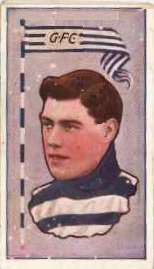Alec Eason
Alexander Eason (8 November 1889 – 5 May 1956) was an Australian rules football player, coach and administrator in the Victorian Football League and Victorian Football Association.
| Alec Eason | |||
|---|---|---|---|
 Cigarette card of Eason in 1912 | |||
| Personal information | |||
| Full name | Alexander Eason | ||
| Date of birth | 8 November 1889 | ||
| Place of birth | Geelong, Victoria | ||
| Date of death | 5 May 1956 (aged 66) | ||
| Place of death | Geelong, Victoria | ||
| Original team(s) | Barwon | ||
| Debut |
Round 12, 1909, Geelong vs. Essendon, at Corio Oval | ||
| Height | 175 cm (5 ft 9 in) | ||
| Weight | 78 kg (172 lb) | ||
| Playing career1 | |||
| Years | Club | Games (Goals) | |
| 1909–1915 | Geelong | 112 (57) | |
| 1916 | Richmond | 12 (8) | |
| 1919–1921 | Geelong | 38 (23) | |
| Total | 162 (88) | ||
| Coaching career | |||
| Years | Club | Games (W–L–D) | |
| 1920 | Geelong | 16 (5–11–0) | |
| 1929 | Footscray | 18 (6–11–1) | |
| Total | 34 (11–22–1) | ||
|
1 Playing statistics correct to the end of 1921. | |||
| Career highlights | |||
| Sources: AFL Tables, AustralianFootball.com | |||
A highly regarded rover, Eason played most of his football for the Geelong Football Club, playing a total of 150 games for the club between 1909 and 1921. His time at Geelong was broken up by World War I: upon Geelong's withdrawal from the league in 1916, he crossed to Richmond and played twelve games there, before enlisting and serving in the war for the next two years. He returned to play for Geelong from 1919 until 1921,[1] earning selection for Victoria in interstate football during that time.[2]
In 1922, Eason crossed to Footscray in the VFA without a clearance,[3] and played there until 1924, continuing to earn high acclaim and winning two premierships; he received £12 per week at Footscray, with the Sporting Globe reporting that he was the highest paid footballer at that time.[1] In 1925, when Footscray joined the VFL, Eason was unable to remain with the club due to his suspension from the VFL for leaving Geelong without a clearance,[4] and he crossed to Brighton for the final year of his senior career.[5][6]
Eason was a talented and hard-working player, nicknamed "Bunny" because of his speed. His accuracy with both kicking (particularly stab-kicking) and handpassing were highly regarded, as was his ability to win the ball from either his or his opponents' ruck tap-outs, and he was considered one of the finest rovers in Victoria in the early 1920s.[1] He had two fingers on his right hand missing, but this did not greatly affect his skill. He is a member of Geelong's Hall of Fame and was named on the interchange bench of the club's Team of the Century. His brother Bill Eason also played for Geelong, and served as captain for four years.
He later coached Footscray in the VFL for the 1929 season and Prahran in the latter part of the 1933 season. He became an administrator at Footscray, serving as chairman of selectors.[7] He was well-regarded for his on-field and off-field wit, and wrote columns for the Sporting Globe.[1]
Eason is buried at the Footscray Cemetery.
Footnotes
- "Brilliancy of veteran Alex Eason". The Sporting Globe. Melbourne, VIC. 3 May 1924. p. 6.
- "Australian carnival – Victorian team". The Argus. Melbourne, VIC. 11 July 1921. p. 3.
- "Will Eason return?". Geelong Advertiser. Geelong, VIC. 25 July 1922. p. 4.
- Qui vive (27 June 1925). "Much discussed player – Norman Ford, of Coburg". The Sporting Globe. Melbourne, VIC. p. 6.
- "Eason for Brighton". The Argus. Melbourne, VIC. 9 July 1925. p. 5.
- "A. Eason to coach Sunshine". The Age. Melbourne, VIC. 8 March 1926. p. 8.
- Alex Eason (7 April 1937). "Making a machine at Footscray". The Sporting Globe. Melbourne, VIC. p. 8.
References
- De Bolfo, Tony (14 March 2017). "200 Club push for 'Mulga', Baxter and Bob". Carlton Football Club.
- Hogan P: The Tigers Of Old, Richmond FC, Melbourne 1996
External links
| Wikimedia Commons has media related to Alec Eason. |